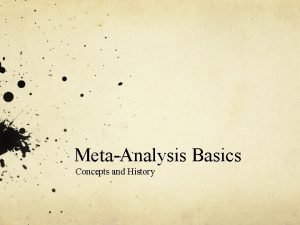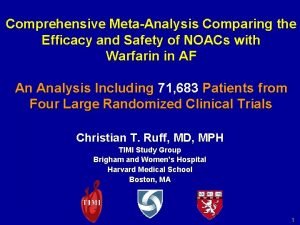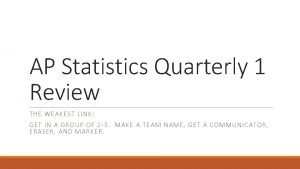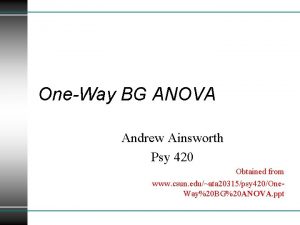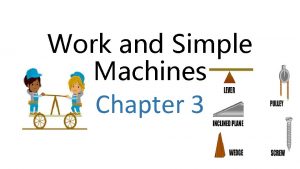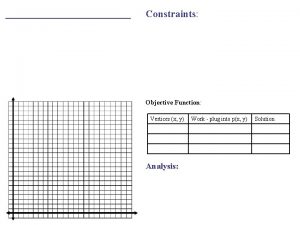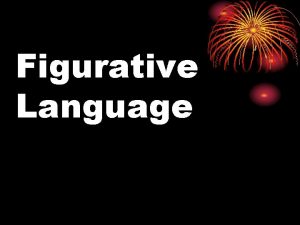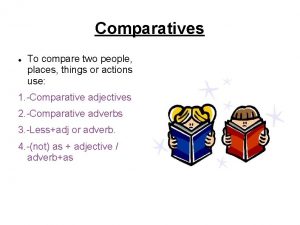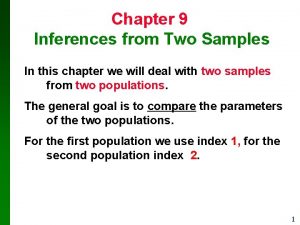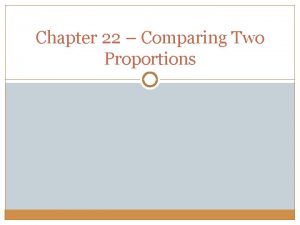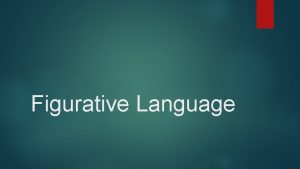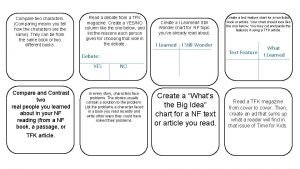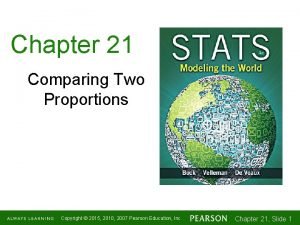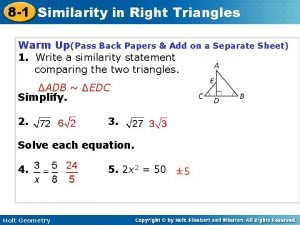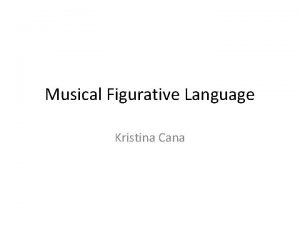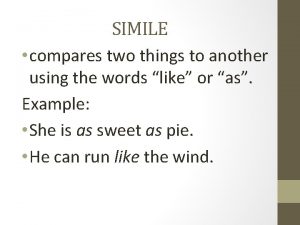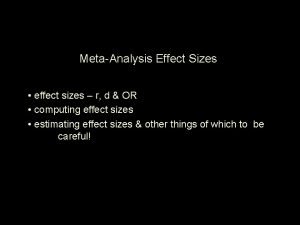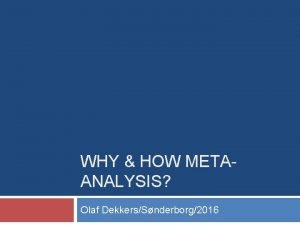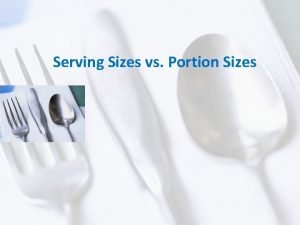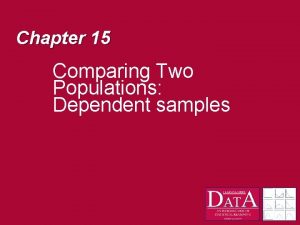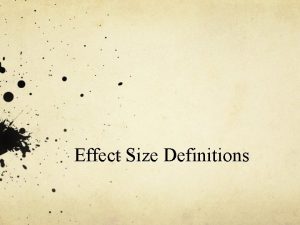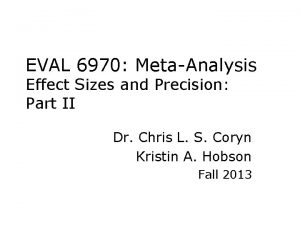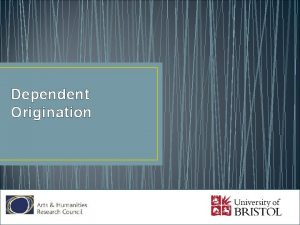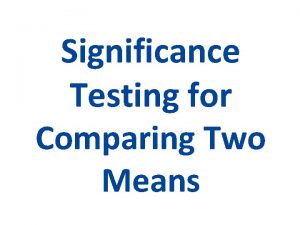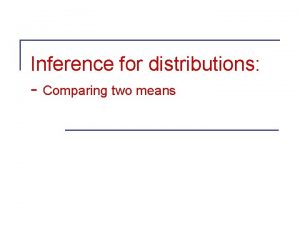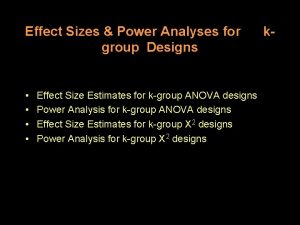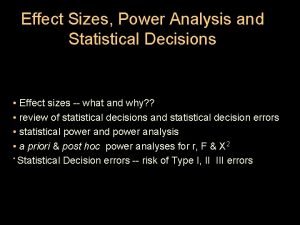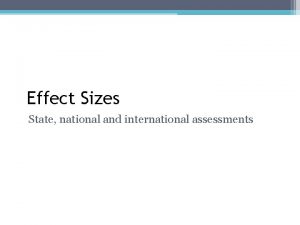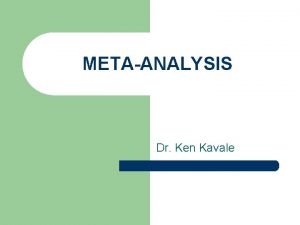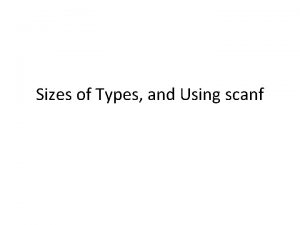Modeling Dependent Effect Sizes in Metaanalysis Comparing Two



















- Slides: 19

Modeling Dependent Effect Sizes in Meta-analysis: Comparing Two Approaches FRED OSWALD, CHEN ZUO, & EVAN S. MULFINGER RICE UNIVERSITY

Intelligently summarize research findings 1. Locate all research within a given domain; screen for relevance (e. g. , err on the side of inclusiveness) 2. Attempt to correct research findings for known sources of bias: (e. g. , various sources of range restriction, measurement error variance) 3. Weight findings by the information provided (e. g. , larger N and less correction in #2 = more information) 4. After the correction and weighting, report the overall mean and variance of the effects (Oswald & Mc. Cloy, 2003) 5. Examine subgroups (moderators): what fixed effects predict random effects variance?

Intelligently summarize research findings 1. Locate all research within a given domain; screen for relevance (e. g. , err on the side of inclusiveness) 2. Attempt to correct research findings for known sources of bias: (e. g. , various sources of range restriction, measurement error variance) 3. Weight findings by the information provided (e. g. , larger N and less correction in #2 = more information) 4. After the correction and weighting, report the overall mean and variance of the effects (Oswald & Mc. Cloy, 2003) 5. Examine subgroups (moderators): what fixed effects predict random effects variance?

Intelligently summarize research findings 1. Locate all research within a given domain; screen for relevance (e. g. , err on the side of inclusiveness) 2. Attempt to correct research findings for known sources of bias: (e. g. , various sources of range restriction, measurement error variance) 3. Weight findings by the information provided (e. g. , larger N and less correction in #2 = more information) 4. After the correction and weighting, report the overall mean and variance of the effects (Oswald & Mc. Cloy, 2003) 5. Examine subgroups (moderators): what fixed effects predict random effects variance?

Intelligently summarize research findings 1. Locate all research within a given domain; screen for relevance (e. g. , err on the side of inclusiveness) 2. Attempt to correct research findings for known sources of bias: (e. g. , various sources of range restriction, measurement error variance) 3. Weight findings by the information provided (e. g. , larger N and less correction in #2 = more information) 4. After the correction and weighting, report the overall mean and variance of the effects (Oswald & Mc. Cloy, 2003) 5. Examine subgroups (moderators): what fixed effects predict random effects variance?

Intelligently summarize research findings 1. Locate all research within a given domain; screen for relevance (e. g. , err on the side of inclusiveness) 2. Attempt to correct research findings for known sources of bias: (e. g. , various sources of range restriction, measurement error variance) 3. Weight findings by the information provided (e. g. , larger N and less correction in #2 = more information) 4. After the correction and weighting, report the overall mean and variance of the effects (Oswald & Mc. Cloy, 2003) 5. Examine subgroups (moderators): what fixed effects predict random effects variance?

Intelligently summarize research findings 1. Locate all research within a given domain; screen for relevance (e. g. , err on the side of inclusiveness) 2. Attempt to correct research findings for known sources of bias: (e. g. , various sources of range restriction, measurement error variance, dependent effect sizes) 3. Weight findings by the information provided (e. g. , larger N and less correction in #2 = more information) 4. After the correction and weighting, report the overall mean and variance of the effects (Oswald & Mc. Cloy, 2003) 5. Examine subgroups (moderators): what fixed effects predict random effects variance?

Dependent effect sizes: What are they? Three types of dependence (Cheung, 2015): 1. Sample dependence – effects arise from the sample [even r(X, Y) and r(Z, Q) are correlated in the sample] 2. Effect-size dependence – effects based on the same or related constructs [this is tau aka SDrho across studies measuring the same effect; but here we’re talking about effects within studies] 3. Nested dependence – effects may come from the same study, the same organization, but the exact nature of nesting is unknown

Handling dependent effects: Old school 1. Take the average and enter it with its cumulative N, (e. g. , 2 studies out of 100). Heterogeneity gets ignored. 2. Treat them as if they were independent (e. g. , 2 studies out of 100). Dependency gets ignored. 3. Keep one of the effects (randomly, based on some rule) and drop the rest. Some effects get ignored. 4. Separate the effects using subgroups (moderators). Dependency still exists across levels, but gets ignored.

…What if there a lot of dependent effects? : New school 5. Take a not-refined-but-parsimonious approach: (a) Robust meta-analysis If total dependency = 1 and complete independence = 0, specify all dependent effects as something in between, like. 80 (. 80 is the default, value doesn’t matter in a wide range of cases) (Fisher & Tipton, 2014; Hedges, Tipton, & Johnson, 2010) (b) Multilevel meta-analysis Dependence cannot be estimated accurately from the data, but there is known clustering; e. g. , effects from the same site; multiple comparisons against a control group (see Konstantopolous, 2011)

…What if there a lot of dependent effects? : New school 5. Take a not-refined-but-parsimonious approach: (a) Robust meta-analysis If total dependency = 1 and complete independence = 0, specify all dependent effects as something in between, like. 80 (. 80 is the default, value doesn’t matter in a wide range of cases) (Fisher & Tipton, 2014; Hedges, Tipton, & Johnson, 2010) (b) Multilevel meta-analysis Dependence cannot be estimated accurately from the data, but there is known clustering; e. g. , effects from the same site; multiple comparisons against a control group (see Konstantopolous, 2011)

Handling dependent effects: New school 6. Take the more-refined-yet-most-complex approach: Account for the level of sample dependency (e. g. , have all correlations), even samples/settings vary in unknown ways, and N may be small (Cheung, 2014; Hedges & Olkin, 1985; Rosenthal & Rubin, 1986) • We were hoping to do this - more studies should report all correlations for the purposes of improved meta-analyses

R code examples: We focus on simpler MA modeling of dependence, applying (a) multilevel modeling and (b) robust MA, to 2 data sets: • Ferguson and Brannick (2002) provide published vs. unpublished effect sizes (converted to z’ scores) across 24 meta-analyses. • Sweeney (2015) examine 10 studies that provided effect sizes related to intentions vs. effect sizes related to behaviors

Cool plots: metaplotr (Brannick & Gültas, 2017)

Ferguson & Brannick (2002) R output M 4 Model M 1. RE - no clustering notes. 17 . 02 . 14 large tau-hat… . 21 (pub). 13 (unpub) . 03. 04 . 13 Compare M 1 & M 2: Use ML not REML p =. 04 and M 2 with < AIC M 3. RE - study clustering . 20 . 03 . 12 Compare M 1 & M 3: Use REML p <. 001 and << AIC for full model M 4. RE - study clustering + FE source . 21 (pub). 14 (unpub) . 03. 01 . 12 Compare M 3 & M 4: Use ML not REML p <. 001 and M 4 with < AIC M 5. robumeta (like M 4) dependence =. 50 . 23 (pub). 13 (unpub) . 02. 03 . 12 no CI for tau M 2. RE + FE source (unpub vs. diss)

Sweeney (2015) R output M 4 Model notes M 1. RE - no clustering . 20 . 08 . 25 gigantic tau-hat… M 2. RE + FE source (intention vs. behavior) . 23 (int). 18 (beh) . 12. 17 . 28 Compare M 1 & M 2: Use ML not REML p = ns M 3. RE - study clustering . 20 . 08 . 19 Compare M 1 & M 3: Use REML p =. 055, minimally < AIC M 4. RE - study clustering + FE source . 22 (int). 18 (beh) . 10. 11 . 19 Moderator ns Compare M 3 & M 4: Use ML not REML p =. 73 (ns) M 5. robumeta (like M 4) dependence =. 50 . 23 (int). 18 (beh) . 15. 17 . 29 no CI for tau

Conclusion • Two MA methods deal with the reality of messy dependence: robust meta-analysis (estimate dependence directy but not clustering) and multilevel modeling (estimate clustering directly but not dependence). • Being messy, these methods reach similar results from a practical perspective, given our examples. • In other words…

Conclusion • • • You can’t always get what you want. But if you try sometimes, well you just might find …you get what you need.

Thank you! (foswald@rice. edu) Modeling Dependent Effect Sizes in Meta-analysis: Comparing Two Approaches FRED OSWALD, CHEN ZUO, & EVAN S. MULFINGER RICE UNIVERSITY
 What is metaanalysis
What is metaanalysis Comprehensive metaanalysis
Comprehensive metaanalysis Men's shirt sizes are determined by their neck sizes
Men's shirt sizes are determined by their neck sizes Effect size small medium large
Effect size small medium large Helen c. erickson nursing theory
Helen c. erickson nursing theory Relational vs dimensional data modeling
Relational vs dimensional data modeling How do you calculate mechanical advantage
How do you calculate mechanical advantage A carpenter makes bookcases in two sizes
A carpenter makes bookcases in two sizes Simile definition
Simile definition Comparing two dissimilar things
Comparing two dissimilar things Quickly comparative
Quickly comparative Comparing two population variances
Comparing two population variances Chapter 22 comparing two proportions
Chapter 22 comparing two proportions Chapter 10 comparing two populations or groups answer key
Chapter 10 comparing two populations or groups answer key A simile compares two things
A simile compares two things Comparing two characters
Comparing two characters Chapter 21 comparing two proportions
Chapter 21 comparing two proportions Lesson 8-1 similarity in right triangles
Lesson 8-1 similarity in right triangles Comparing two things without using like or as
Comparing two things without using like or as Compares two things using like or as
Compares two things using like or as
